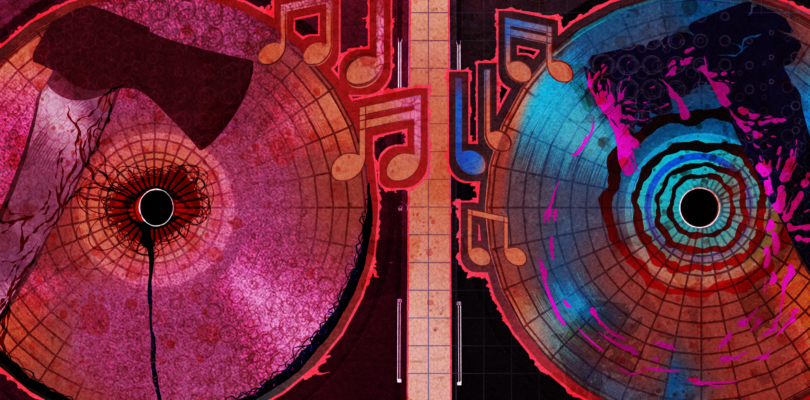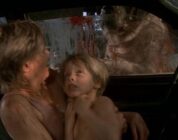Horror, a genre long hated by critics and adored by the public, has always strived to challenge the status quo. Between pushing what can be shown on screen and the sanity of mothers everywhere, the genre has never been one for subtlety — the subject’s long since expanded from chocolate syrup down the drain. The genre’s evolution have been underscored by purposeful and advanced music choices. The influence of a film’s score can’t be overstated. Horror movies’ music has been the backbone as the genre trudged from the creature flick into the slow-burn thriller, having gone through just as many metamorphoses as the genre itself.
Classic Slasher Films
The classic horror films of New Hollywood are known for invoking a sense of campiness that can only be described with one word: iconic. From the ’70s to the ’80s, the horror genre showed viewers how fear could be greater than things that go bump in the night. Horror filmmakers realized that, oftentimes, the most threatening kind of fear treads the line between fiction and reality. With this in mind, the horror genre underwent a transformation, and filmmakers pondered how they could create a more realistic and accessible antagonist, shying away from the impossibility of the paranormal. Thus, the slasher film was born.
In these films, the villains were no longer ghosts or ghouls but something worse: They were insane. The killer in slasher films helped filmmakers explore the psychological implications behind insanity and murder. And if the killer was the weapon, music was its enabler. After all, the evocative recollection of these films is largely due to the impressions that their scores left behind. Orchestral pieces initially lured movie-goers to theaters; now, they have become reminders of horrors’ scariest moments. From Alfred Hitchcock’s (“Psycho”) string symphony to Stanley Kubrick’s (“The Shining”) art-music creations, grand scores have haunted the big screen. In slashers, an expressionistic score is essential to the crazed killer — and, by extension, these classic horror movies.
From the ominous vibrato of a suspenseful piece to the thunderous volume of a dramatic composition, these films all have music that provides them with the space to bring fear to life. In a fashion that is reminiscent of silent films, they allow their music to speak for itself by warning viewers that something spooky is right around the corner.
These films tend to climax with an outlandish run that will seemingly never end. Whether it is a life-or-death dash through a hedge maze or an escape from a suburban labyrinth, the chase scene is always accompanied by a loud, grand piece of music. “Friday the 13th: The Final Chapter” plays a threatening, triumphant sounding as its antagonist, Jason the killer, finally tracks down his victims. The whole chain was composed by the famous Harry Manfredini, who was not new to the horror genre of the ’80s. Soundtracks such as this one rely on primarily orchestral compositions, which are so grandiose and dramatic that audiences can almost picture they are in a great theater watching a live performance.
And if the victim isn’t running, they are often hiding, while the killer roams around, searching for their prey. The most famous example of this convention is from “The Shining,” in the famous REDRUM scene, when Jack chops down the door of the bathroom that his wife, Wendy, is hiding in. One of the most noteworthy elements of this moment is the music, which sounds like glass breaking, nails on a chalkboard or some other stressfully escalating noise. At the time, scores were generally original and composed for the intended film. However, Kubrick was an advocate for playing around with pre-existing music to find his precisely desired sound. The music of this scene in particular comes from the famous Krzysztof Penderecki’s “Utrenja,” a Polish composition inspired by the Bible, which was meant to express the grief of Christ’s tragic death. Kubrick gave Penderecki’s biblical message a new life through his own characters, as Jack’s family grieves the death of his sanity. Following this theme, “The Shining” also uses the iconic “Dies Irae,” quite literally the song of death. This ominous Catholic procedural chant has become famous in film for signaling that something horrible is about to strike. Recreated by different artists, this melody certainly carried on past “The Shining,” haunting generations of cinema, as it appeared in pictures ranging from “Star Wars: Episode IV – A New Hope” to “Home Alone.”
While some of these scores sound outdated, they have laid the groundwork for horror to build its web of frights. The “Scream” series, originating in the ’90s, followed in the footsteps of these epic killer pictures but added dark, comedic twists that made light of the absurdity of a masked killer chasing its victim to no avail. Following an increasingly modern trend, the Scream franchise drew from a wide variety of songs, not made for the film, but rather repurposed from a broad range of unique artists. Hand-picking these songs allowed the filmmakers to tailor the complex genre they were creating, both horrific and comedic. Some of these songs, such as “Red Right Hand” by Nick Cave and the Bad Seeds still have the dramatic crescendos of classical pieces, but with the use of lyrics, there is an obvious shift away from orchestral tracks, turning toward rock. During this period, if striking, classical-sounding pieces are used, they are often for ironic purposes, poking fun at over-exaggerated scenes of past horror films. “Silence of the Lambs” was, in many ways, a slasher and further explored the psychological relationship between insanity and premeditated murder. The film partially circled back to tradition, with a suspenseful, orchestral score, composed by Howard Shore, yet incorporated modern songs as well. In fact, its orchestral score got primarily brushed over, as the song “American Girl” by Tom Petty and the Heartbreakers gained the most association with the picture. It was clear: Horror filmmakers were slowly pushing out sounds of the past for the creative music of the present.
In many ways, the slasher movies of the ’70s and ’80s were revolutionary in exploring the concept of insanity. They showed that man himself could be just as frightening as any monster. The scores of these films create the perfect playground for a masked killer to chase down their prey, and, in doing so, they helped slashers examine the psychology of insanity, illuminating some truths about the darkness of humanity.
Modern Horror
Societally, with our ever-expanding virtual accessibility to real atrocities, we’ve moved past the effectiveness of jump scares and axe murderers hunting down the final girl, but we haven’t lost this strange paradoxical desire to feel afraid. Humanity, ever the persistent creative, has capitalized on that; filmmakers know their audiences don’t need cinematic mundanity. People want, for whatever reason buried in our unevolved hindbrains, this. Whether it comes from the slut-shaming slasher tropes of the ’80s or the psychologically abusive absurdism of the thriller, modern horror has diverged in two major directions: the gore fest and the decorative drama. We want to feel an unsettling narrative devour our psyches, and while the visuals of the spectacle captivate the modern horror fanatic, the music of these pieces carries an arguable amount of weight, lulling them into this bloody fiction.
Like its blood-soaked teenagers and slow-moving antagonists, the orchestral score of classic horror has slowly been replaced. The sadistic gore fests of the 2000s, desperate to rebel against their forefathers of classical storytelling and male gaze, leaned hard into the alternative, unsavory musical genres as a substitute. Anecdotally, my first real brush with metal was “Saw.” Despite the film’s egregious lack of quality and its apparent aversion to realism and acting, “Saw’s” sonic landscape wrapped its clammy bone-breaking grip around my personality and revealed the brutal intentions behind this subgenre of horror — to disgust the mainstream. Being the desperately edgy kid I was, I latched onto both metal and gory horror with a ferocity rivaling the film’s antagonist. But “Saw’s” musical choice did more than give some emo kid a weird hyperfixation for life. Exemplified by Mushroomhead’s “Saw IV” collaboration project, “Your Soul Is Mine,” the franchise’s fixation on aggressive music proved these films weren’t like their predecessors. “Saw,” and others like it, are not for the critic, not for uninterested teenagers going on a first date; these films are for the outsider, and their music reflects that. These films were for the guy who prefers living in the basement, the Hot Topic frequent flyer or Rob Zombie’s favorite type of woman, but catering to the alternative wasn’t the horror genre’s only evolution.
Just as sadistic as “Saw” and twice as artistic: “Climax,” a self-described horror-musical, perfectly curated the soundtrack for their hallucinogenic film examining the last night of a French dance troupe. With several dance scenes relying entirely on diegetic brassy EDM, “Climax,” for all its gut-wrenching narrative and gorgeous cinematography, curates a prodigious score. It is a score whose brightness does nothing to alleviate the darkness of the film’s through line; really, all the buoyancy of the music manages is to happily juxtapose the film’s misanthropic plot and leave the audience with an even more severe sense of dread.
Executing a similar fascination with the synth-heavy subgenre, 2024’s “The Substance” leaned even harder into the distorted club sound, using fleshy hell montages set to a hateful bass line to echo the film’s misogynistic through line. Its twisted, droning love letter of a track compliments the mutating youth-obsessed characters and results in one of the best entries into the body-horror subgenre since “Society.” Both “Climax” and “The Substance” rely heavily on their scores as a means of referencing the glamorous romanticized nightlife sphere, and both manage to mutilate that daydream of a night out. This subgenre of horror isn’t about a single villain; rather, it’s about tainting the normalcy of the everyday, of giving a body to societal horrors like patriarchal ageism and drug abuse. These films, with bass-y scores, challenge the integrity of speakers. In doing so, they show these narratives that we all live under but rarely have to acknowledge the monstrosity of.
With the overexposure to horror in its many different forms, older films have lost some of their fright factor. Moments that used to make audiences jump out of their seats at the local cinema now receive milder reactions, especially as audiences passively play the film on Netflix while scrolling TikTok. This is where modern horror has found its allure. It has creatively built new spaces for fear to exist, each one producing more winces and disturbance than the next. It has created electronic soundscapes that bring more complex emotions to the center of the horror viewing experience. These experimental techniques capture and hold audiences’ attention by deepening the suspense, chaos or grotesqueness of a film. Traveling back to the grand horror scores of the ’70s and ’80s is an ode to the simplicity of fear, but watching the evolving complexity of modern horror music is an ode to its realism. Fear is not always found in a monster or a killer, but in society itself.
Daily Arts Contributor Abigail Weinberg and Senior Arts Editor Mivick Smith can be reached at weinab@umich.edu and rmontsmi@umich.edu, respectively.




